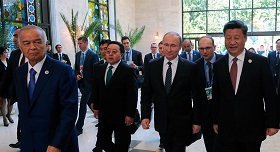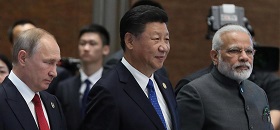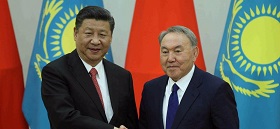Less than a month remains until the next summit of the Shanghai Cooperation Organisation (SCO), which will take place in Qingdao, China on June 9 and 10. The event is already being touted by the media and official figures of the participating countries as one of the most important international events of the year. All the more so because it will mark the first time that the six member states (China, Kazakhstan, Kyrgyzstan, Russia, Tajikistan anthd Uzbekistan) are joined by India and Pakistan. Journalists and analysts were quick to point out that the participants account for a sizeable share of world’s population, territory, natural resources and economic potential. The impressive figures suggest that the SCO will inevitably become a key “load-bearing structure” of the future world order.
There is no denying the strides made by the organization in terms of its institutional development since its inception at the turn of the century. And, of course, it would be bad form to look down on the diplomats, officials and experts who have invested so much energy in building the SCO over the past two decades. However, it is also true that now is not the best time for high fives and victorious statements. The SCO has obviously entered adulthood, but it has not yet emerged as a fully mature international institution. Furthermore, it runs the risk of becoming an “eternal teenager,” with its numerous transition problems and frequent changes in hobbies and attachments, but without any particular occupation or specific purpose in life.
Choosing the Priorities
At the turn of the century, Russia and China were extremely concerned about the growing global and regional instability. On the one hand, the growing threat of international terrorism, political extremism and separatist movements was already quite evident. On the other hand, the reaction of the West, primarily of the United States, to these challenges raised many questions and objections. It is no coincidence that the first substantive SCO document, adopted by the six member states in the summer of 2001, was the Shanghai Convention on Combating Terrorism, Separatism and Extremism.
However, in the very first years of the SCO there was a significant disparity in the interpretations of the “three main evils” and ways to counteract them. Not only did these differences persist, but in many instances they even grew over time. For example, the SCO member states backed the Russian counter-terrorist operation in the North Caucasus in the early 2000s, but Moscow’s decision to recognize the independence of Abkhazia and South Ossetia in 2008 was not met with similar support, for obvious reasons. And the reaction of the SCO member states to Russia’s annexation of Crimea in 2014 was an even more clear signal of the diverging approaches to separatism.
The interpretations of the other two “evils” have also diverged on a number of occasions. These differences would come to the fore every time a conflict emerged, such as in the case of Uzbekistan’s relations with Tajikistan and Kyrgyzstan. What some SCO members viewed as political extremism or downright terrorism others perceived as the legitimate struggle of ethnic minorities for their rights. As for the settlement of complex territorial disputes between China and the post-Soviet states of Central Asia, these problems were mainly resolved through bilateral negotiations, rather than with the help of multilateral SCO mechanisms.
Unfortunately, the SCO cannot as yet boast any significant contribution to solving the Afghan problem, one of the most burning security problems in the region. The SCO Afghanistan Contact Group was established in 2005, and Kabul received observer status within the organization in 2012, but the situation in that country has hardly improved over the past 10 years. It would be wrong to blame the lack of progress exclusively on the SCO, but the organization’s current status of cooperation with Afghanistan is hardly cause for celebration either.
Trying to Diversify
To be fair, the SCO’s work to coordinate efforts in countering international terrorism, separatism and extremism has already brought some practical results and acquired certain positive dynamics. The new Programme of Cooperation among the SCO Member States on Counter-Terrorist, Counter-Separatist and Counter-Extremist Measures for 2019–2021 is expected to be approved at the Qingdao summit. The organization’s anti-drug strategy is in the final stage of development. Other plans include intensifying operations of the SCO’s regional anti-terrorist structure.
Yet it would be an exaggeration to say that the SCO serves as a framework for a common security strategy of its member states. Just like before, the main efforts aimed at developing cooperation are focused on bilateral relations, primarily relations between Russia and the other SCO member states. The SCO itself remains largely a “geopolitical showcase” intended to demonstrate the effectiveness of “non-Western” approaches to multilateral cooperation, and to the world order in general.
At some point, China attempted to shift this focus to less sensitive areas of potential cooperation. In particular, Beijing proposed strengthening the economic dimension of the SCO’s activities, up to and including setting up a free trade zone and fostering economic integration among the member states. Though nobody objected to this proposal, China’s partners proved predictably unprepared for such a development. They all were seriously concerned about Beijing’s possible economic expansion, and none of them was particularly enamoured with the prospect of becoming an economic appendage of China.
Moscow had its own concerns about the Chinese proposals. Russian experts believed that intensified economic cooperation within the SCO aimed at a future free trade zone would eventually lead to that organization replacing the Eurasian Economic Union (EAEU) as the key driver of Eurasian integration, thus depriving Russia of the central role in this process.
As a result, the idea of a free trade zone was only actively supported by Kazakhstan and has not yet resulted in any detailed expert evaluations. China was eventually forced to shift the focus of its economic strategy in Eurasia from the SCO to the One Belt One Road Initiative, and the free trade zone idea is hardly ever mentioned in the latest SCO documents.
In practice, the role of the SCO was reduced to that of bringing bilateral or tripartite sub-regional economic projects together under one roof. This umbrella organization may have done something to conceal China's economic domination in the region, but it did not change the essence of the ongoing processes.
Expansion Dilemmas
With all its teething problems, the SCO’s two potential development trajectories remained relatively open. Until recently, that is. The organization could continue with its attempts to reach a new level of multilateral cooperation on security while trying to expand the scope of this cooperation by tackling unconventional threats and challenges head-on. Or it could strengthen its economic component consistently, gradually nearing the establishment of a free trade zone, albeit not as fast as Beijing would like.
The Development Strategy of the Shanghai Cooperation Organisation Until 2025 adopted at the July 2015 summit in Ufa was presented in an oversimplified way and allowed for various priorities to be set and various scenarios for the further development of the SCO to be implemented. However, the expansion of the organization that followed two years later changed its prospects significantly, narrowing the once-ample scope of opportunities. By embracing India and Pakistan, the SCO passed an important point of no return in its institutional development.
It is not about the expansion per se. Had the SCO accepted Mongolia, Turkmenistan and Belarus – or even Vietnam or a post-UN sanctions North Korea – as full members, for example, the power balance within the organization would not have change in any significant way. The SCO’s political foundations would also have remained the same. Just like the original six SCO member states, the aforementioned countries are believed to be communist or post-communist; they share many “generic features” and a long history of interaction with one another in a variety of formats. Not all of these countries can be viewed as convenient partners, but it is unlikely that many current members, such as Uzbekistan, can be treated as such either.
The expansion of the SCO through the addition of India and Pakistan presents fundamentally different problems. These two new members radically change the geographic, demographic, strategic and political balance within the SCO. More importantly, they bring the burden of bilateral conflicts, severe political differences, territorial disputes, historical grievances and mutual suspicions to the organization. There are conflicts, territorial disputes and mutual suspicions among the original SCO members, but nothing close to the Kashmir problem when it comes to longevity, intensity and the loss of life.
In addition, neither India nor Pakistan belong to the (post-)communist world: the two countries share the British colonial legacy and have a completely different experience of statehood and political development (incidentally, the SCO’s official languages have always been Russian and Chinese, not English). The SCO must also contend with the complicated relations between India and China.
At the present time, it is difficult to predict how the SCO’s expansion will affect its operation. Most likely, it will now be much more difficult to find a common point of contact on the most pressing strategic, political and economic problems. And there is a new potential complication on the horizon: Iran and Afghanistan are planning to join the organization and will thus bring their own views on global politics and strategic stability and their own ambitions and interests with them.
As has been repeatedly demonstrated by other intergovernmental associations, attempts to expand an organization while trying to deepen ties within it carry significant risks. As a relatively young and not completely developed structure, these risks are particularly high.
Institutional Rivals
One opinion has it that Eurasia is suffering from an “institutional deficit” – a lack of complementary multilateral development and security institutions found in abundance in other regions. This suggests that there should be as many such institutions as possible.
The idea is correct, in a sense: Eurasia is not yet fully formed as an independent region; until recently, its various parts belonged to other geopolitical and civilizational entities. Yet we must remember that a number of inter-regional and global structures gravitate towards Eurasia in one way or another. This means that the SCO is still facing institutional competition, albeit in an implicit and relatively mild form. We have already mentioned the SCO’s rivalry with the EAEU, but this is not the only possible scenario.
For example, the BRICS organization (which includes Brazil, Russia, India, China and South Africa) is based on the Eurasian triangle of Russia, India and China (the “RIC” part of the acronym). Now that India is a member of the SCO, the latter has come to reproduce, somewhat belatedly, the Eurasian triangle of BRICS; this implies potential rivalry between the two structures, which the SCO is likely to lose in the end. Even though BRICS was established five years after the SCO, institutionally it is more developed in a number of aspects. Suffice it to compare the New Development Bank (NDB), which is operating successfully under the auspices of BRICS, and the numerous SCO Development Bank and Development Fund projects that have yet to materialize.
In terms of security, much has been said about the dangers of competition between the SCO and the Collective Security Treaty Organization (CSTO). Even though the functions of the two organizations do not overlap entirely, and the composition of their participants is different (the CSTO comprises Armenia, Belarus, Kazakhstan, Kyrgyzstan and Tajikistan), the two entities have obviously similar missions. This could actually have come in handy had they competed in resolving the very serious 2010 Kyrgyz crisis, for example. However, both organizations preferred to disassociate themselves, or at least minimize their intervention.
It would be fair to note that, despite the CSTO’s numerous shortcomings, its future as the key security organization at the centre of Eurasia appears to be more favourable than that of the SCO (especially considering the fact that the latter has now been joined by the strategic antipodes of India and Pakistan). In fact, many of the security issues in the region will continue to be resolved bilaterally rather than multilaterally.
So, it turns out that the continuing institutional weakness of the SCO, coupled with its extremely broad mandate and the erosion of the Russia–China core through the adoption of new members can transform the organization into a suitcase without a handle: something too unwieldy to carry but too precious to abandon. It is, of course, true to say that the SCO remains useful as a discussion platform for global and regional problems, with all its ministerial summits and meetings. But can ceremonies and non-specific political declarations remain a sufficient justification for the organization’s existence in the long run?
The European Experience
The solution can often be found in the same place as the problem. It is in the institutional weaknesses of the SCO that its unique role in the Eurasian space can be found. The inclusion of India and Pakistan suggests the direction for the organization’s further development. It is clear that, with India and Pakistan on board – and even more so if Iran and Afghanistan join the club – the SCO will never again be the same group of like-minded countries it was supposed to be two decades ago. Nevertheless, it can become a platform for communication between potential or actual opponents, a tool for developing uniform standards and rules of conduct within the multi-directional and potentially highly conflict-prone Eurasia of the 21st century.
History offers examples of international institutions that were created (and operated successfully) not as alliances united by common goals and values, but rather as mechanisms for the interaction of opponents. Perhaps the most well-known example of this was demonstrated by Europe from the 1970s to the 1990s. Following two years of hard work, the summer of 1975 saw the signing of the Final Act of the Conference on Security and Co-operation in Europe (the Helsinki Accords), which postulated the fundamental rules of the game as applied to the continuing division of the European continent.
The Conference on Security and Cooperation in Europe (CSCE) was established as a permanent international forum of all European countries, as well as the United States and Canada. Unlike the OSCE, which superseded it in January 1995, the CSCE was created at a time when any unification of Europe under the umbrella of common values and coinciding interests was out of the question.
1970s Europe and present-day Eurasia are obviously very different. For example, back then, Europe was rigidly bipolar, whereas Eurasia of today is seeing multi-polarity grow in the absence of clearly defined political and military alliances. In 1970s Europe, the pressure of global problems (climate change, the scarcity of resources, migration) was still almost imperceptible, whereas today’s Eurasia is suffering from them more and more each year. Europe was mostly focused on conventional security, whereas Eurasia needs to respond to unconventional challenges, from international terrorism to cybercrime. In Europe, first they agreed on the principles and then they created an appropriate international structure. Something completely different may happen in Eurasia – the existing structure may have to come up with new principles and rules of the game.
But the main thing is that in Eurasia, just like in Europe in the 20th century, there is an urgent need to define the general parameters of interaction in the context of profound differences between the continent’s countries on many fundamental issues – differences that are unlikely to be overcome in the foreseeable future. Managing competition is no less important than developing cooperation in this context. And the SCO could play a very important role here.
The Way to the Future
What does this mean in practice? First, now that the SCO has started expanding, it must continue with this process. The more members there are, the more legitimate the organization will grow. The prospects for further expansion are very good. At the moment, in addition to the eight full members, the SCO includes four observers (Afghanistan, Belarus, Iran and Mongolia), 10 candidate observers (Bahrain, Bangladesh, Egypt, Iraq, Israel, Maldives, Qatar, Syria, Ukraine and Vietnam) and six dialogue partners (Armenia, Azerbaijan, Cambodia, Nepal, Sri Lanka and Turkey). In other words, almost 30 Eurasian countries are already in the SCO orbit. In the first years of the SCO’s existence, considerable work was done to develop the criteria and specific provisions, first for obtaining observer status and then for obtaining the status of dialogue partner.
Second, just like in Europe of the 1970s, the SCO might become a platform for discussing and devising the fundamental principles of relations in situations of differing or conflicting interests. New Helsinki Accords for Eurasia? Why not? Not in the format of the original document, of course: the world has changed since then, so too have global politics. The “10 Helsinki principles” should be amended for Eurasia in the light of what has happened over the past four decades.
Third, we must abandon the idea of seeking a “narrow specialism” for the SCO; in fact, the organization’s existing specialisms should be expanded further. As is known, the CSCE was built on the basis of “three baskets” or chapters: 1) “questions relating to security in Europe” – arms control, conflict prevention and confidence-building measures; 2) “cooperation in the fields of economics, of science and technology, and of the environment” – trade and economic aspects of cooperation, as well as environmental security; 3) “cooperation in humanitarian and other fields” – the protection of human rights, the development of democratic institutions, and the monitoring of elections.
In modern Eurasia, the three most important dimensions of international life (security, economic development and the humanitarian dimension) develop primarily in parallel. They are managed by various bureaucratic structures, their budgets rarely overlap, and experts tend to concentrate on one of the three dimensions. The SCO’s updated mechanisms could be instrumental in integrating these three dimensions into uniform multilateral projects.
The future of the SCO may consist not only in successful competition with other Eurasian organizations, ad-hoc coalitions or continental international regimes, but also in the role of integrator for the efforts of numerous players in the Eurasian political arena. If the SCO fills this niche, it will complement other regional and inter-regional structures such as BRICS, the CSTO, the Asia-Pacific Economic Cooperation (APEC), the EAEU, the Association of Southeast Asian Nations (ASEAN), the G20, etc. Moreover, the SCO already has cooperation agreements with most of these organizations. Now it needs to implement those accords in practice.
This will turn the SCO into a cornerstone which, while scornfully rejected today by many ambitious builders of new Eurasian security and development structures, will sit at the heart of the building yet to be erected.








